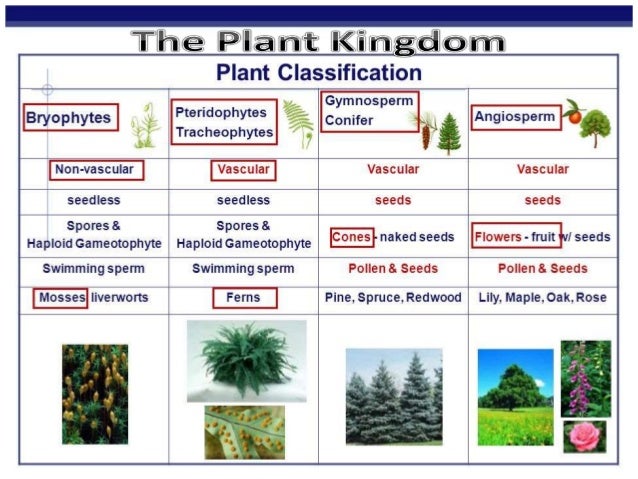What are the Major Divisions in the Plantae?
Divisions of Kingdom Plantae
The kingdom Plantae is divided into five main divisions and they are as follows:
- Thallophyta
- Bryophyta
- Pteridophyta
- Gymnosperms
- Angiosperms
These divisions are based on the following criteria:
• Differentiated/Undifferentiated plant body
• Presence/absence of vascular tissues
• With/ without seeds
• Naked seeds/seeds inside fruits
Thallophyta
Thallophyta is the first division of the plant kingdom. Algae and fungi are the two main sub-divisions. It also includes bacteria, molds, lichens, and slime.
Features of Thallophyta:
- They have a simple body design with no differentiation into root, stem and leaves.
- They have unicellular reproductive organs.
Bryophyta
Bryophyta are known as the amphibians of the plant kingdom. Mosses, hornworts, and liverworts are the three main sub-divisions.
Features of Bryophyta:
- They do not have roots but have crude stems and leaves.
- The roots are replaced by the rhizoids which acts as an anchor.
Pteridophyta
Pteridophyta are the vascular plants that use spores for reproducing. They are also known as cryptogams as they do not produce flowers and seeds. Ferns, lycophytes, and horsetails are the three main divisions of Pteridophyta.
Features of Pteridophyta:
- They are multicellular. The male sex organ is known as antheridia and the female sex organ is known as archegonia.
- They contain vascular tissues.
Gymnosperms
Gymnosperms are the flowerless plants which produce cones and seeds. The term gymnosperm means “naked seeds”. Coniferophyta, cycadophyta, ginkgophyta, and gnetophyta are the four divisions of gymnosperms.
Features of Gymnosperms:
- They are pollinated by the wind.
- They produce needle-like leaves.
Angiosperms
Angiosperms are the flowering plants. Approximately 80 percent of the known green plants are covered by the angiosperms. Monocotyledonous and dicotyledonous plants are the two divisions of angiosperms.
Features of Angiosperms:
- They have vascular bundle with xylem and phloem tissues.
- The root system of this division of plant kingdom is fully developed.

The Importance of Plants
The importance of plants to humans and just about all other life on Earth is staggering. Life as we know it would not be possible without plants. Why are plants so important?
- Plants supply food to nearly all terrestrial organisms, including humans. We eat either plants or other organisms that eat plants.
- Plants maintain the atmosphere. They produce oxygen and absorb carbon dioxide during photosynthesis. Oxygen is essential for cellular respiration for all aerobic organisms. It also maintains the ozone layer that helps protect Earth’s life from damaging UV radiation. Removal of carbon dioxide from the atmosphere reduces the greenhouse effect and global warming.
- Plants recycle matter in biogeochemical cycles. For example, through transpiration, plants move enormous amounts of water from the soil to the atmosphere. Plants such as peas host bacteria that fix nitrogen. This makes nitrogen available to all plants, which pass it on to consumers.
- Plants provide many products for human use, such as firewood, timber, fibers, medicines, dyes, pesticides, oils, and rubber.
- Plants create habitats for many organisms. A single tree may provide food and shelter to many species of insects, worms, small mammals, birds, and reptiles.




